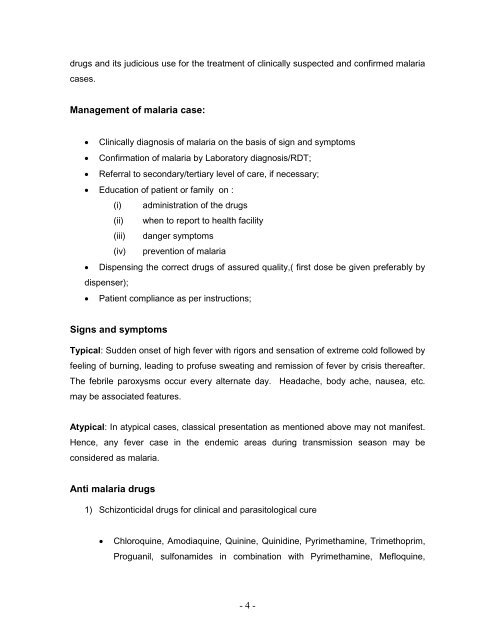MALARIA DRUG POLICY (2007) - NVBDCP
MALARIA DRUG POLICY (2007) - NVBDCP
MALARIA DRUG POLICY (2007) - NVBDCP
You also want an ePaper? Increase the reach of your titles
YUMPU automatically turns print PDFs into web optimized ePapers that Google loves.
drugs and its judicious use for the treatment of clinically suspected and confirmed malariacases.Management of malaria case: Clinically diagnosis of malaria on the basis of sign and symptoms Confirmation of malaria by Laboratory diagnosis/RDT; Referral to secondary/tertiary level of care, if necessary; Education of patient or family on :(i) administration of the drugs(ii) when to report to health facility(iii) danger symptoms(iv) prevention of malaria Dispensing the correct drugs of assured quality,( first dose be given preferably bydispenser); Patient compliance as per instructions;Signs and symptomsTypical: Sudden onset of high fever with rigors and sensation of extreme cold followed byfeeling of burning, leading to profuse sweating and remission of fever by crisis thereafter.The febrile paroxysms occur every alternate day. Headache, body ache, nausea, etc.may be associated features.Atypical: In atypical cases, classical presentation as mentioned above may not manifest.Hence, any fever case in the endemic areas during transmission season may beconsidered as malaria.Anti malaria drugs1) Schizonticidal drugs for clinical and parasitological cureChloroquine, Amodiaquine, Quinine, Quinidine, Pyrimethamine, Trimethoprim,Proguanil, sulfonamides in combination with Pyrimethamine, Mefloquine,- 4 -
















